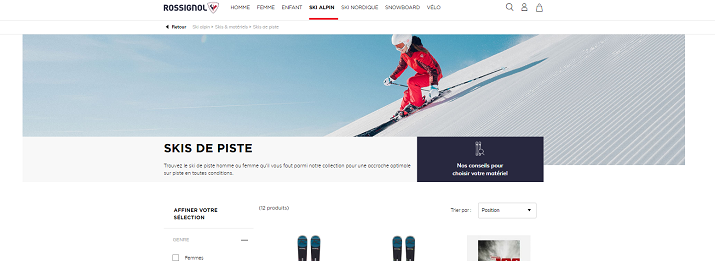
Fasterize is a SaaS solution. But it is also a team of experts who carry out audits and give advice on Front End optimisation. Rossignol was experiencing performance problems on its French e-commerce website, and load times abroad were still long. By implementing Fasterize’s recommendations, browsing became significantly smoother, thus improving UX and business results and also reassuring their investors.
Meeting with Damien Hars, Digital Marketing & E-commerce Technology Director of the winter sports equipment supplier, who managed this project.
Fasterize: What made you decide to carry out a web performance audit?
Damien Hars: We manage 4 brand websites in a dozen countries, so we have more than 40 stores hosted by Magento. Rossignol.com experiences its heaviest traffic between December and March, with a peak of 2.2 million unique visitors in skiing countries (North America and Alpine Europe) during this period.
In late 2017, we started a full technical redesign and migrated to a single platform supported by Magento 2 Cloud Edition for all our websites across the world.
This redesign took place over 12 months and involved a lot of resources, time and budget to set up the functional rules that enabled us to link up the website, our ERP, our CRM and the commercial management tools.
Due to the complexity of interlocking all these elements, and although the commercial performance was very good, we had neglected the Front End and UX aspects.
As a result, the website had obvious performance problems, flagged up internally by several countries, particularly in North America and Scandinavia where the load time could be as long as 10 to 15 seconds.
We had to correct this because we were running the risk of poor user feedback, an SEO penalty and seeing our turnover plummet.
In the course of a board meeting with our Norwegian investors, we started a discussion on user experience. Our very ambitious objective was to achieve a load time of 1 second in less than 6 months. This meant dividing the Speed Index by 10!
We already had a CDN included with Magento but it was not enough. With the server settings, the CDN, HTML integration etc., 80% of our performance problem was technical and we needed an expert eye to speed up our website. So we asked Fasterize to carry out an audit to find out how we could improve our web performance and rise to this huge challenge!
What possible improvements did the audit identify, and what lessons did you learn from this?
D. H.: Fasterize carried out a very comprehensive audit of Rossignol.com. This produced almost 40 technical points for improvement, around ten of which were reported as critical.
We also consulted Magento to audit our infrastructure at the same time. Once all the recommendations had been consolidated and a roadmap defined, we launched a real commando operation!
We started by prioritising the recommendations according to the extent of their impact on the load time.
As our baseline web performance metric was Speed Index, we concentrated our efforts on the assets above the float line.
The most critical points that we decided to address as a priority were as follows:
- our CDN configuration according to the user’s location, which enabled us to halve our load times;
- cleaning the code, especially JavaScripts coming from Magento and used by default, which we concatenated;
- optimising images: because our website is responsive, we defined the images to be loaded, or not, on mobile devices through our customisable CMS code. We made sure that we found the best compromise between the IT and marketing constraints: keeping quality images that were light in weight, and avoiding loading purely decorative images on mobile devices.
How did you organise your teams to implement the recommendations of the Fasterize audit?
D. H.: Firstly, we identified the optimisations that required development and that we wanted to delegate to our web developer Magento, revising their roadmap in that direction; and secondly, we identified the optimisations that we were able to deal with and prioritised them.
The operational implementation of the audit recommendations took place over 8 weeks, by coordinating 2 resources from the IT and marketing teams to approve our objectives and, above all, identify errors that we wanted to avoid in future.
We also adopted a monitoring tool (Dareboost). This was essential in order to track the development of our KPIs and confirm the impact of the optimisations deployed in production.
We also continued discussions with Fasterize to adjust the optimisations for which we were not noting the expected effects, as some of these required specific adjustments.
In this way, we quickly succeeded in reducing our load time to 1.9 seconds, meaning a Speed Index divided by almost 10, something we had not even dreamed of at the start of the project!
In addition to this, according to our analytical tools, the Rossignol.com conversion rate improved by 94% when compared to the previous year over the period 15 September to 15 December. This performance cannot be attributed 100% to the load time, as there are many factors involved, but the web performance optimisations certainly played an important part. These improvements also provided easier browsing for our users!
And what work are you doing now on your web performance?
D. H.: Web performance requires attention on a daily basis. We are aware of the fact that everything can collapse with incorrect handling. Since working on optimising our load times, we have also continuously monitored the KPIs. This work required such a big effort and the results were so conclusive that we want to maintain them.
We therefore made the decision not to have a dedicated web performance team but to involve all departments: web design, marketing, Product Information Management, IT, e-commerce, etc. Web performance has become everyone’s business!
Would you like to find out more about our web performance audits
and have one of our experts contact you?
